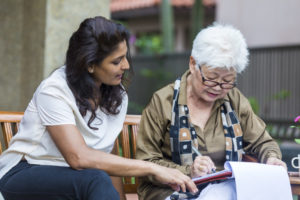
“You ran into the back of me!”
“No, you “cut in” front of me!”
Wouldn’t it be lovely if we lived in a world where everyone told the truth? Unfortunately the truth is often hard to find. Conflicting truths battle it out in a game where victory is never really certain. In the case of the ‘he said, she said’ motor vehicle accident, even small discrepancies between one version of events and another could make a big difference to the outcome.
In most cases, a party may not intentionally lie, although sometimes they can! Unfortunately this can only exacerbate the problem, with both parties vehemently sticking to their truth. With more than financial consequences at stake, a ‘he said, she said’ motor vehicle accident can quickly become very messy. Find out what you should do when they say one thing and you say another…
What Should You Do Immediately After the Accident?
Any motor vehicle accident can turn into a ‘he said, she said’ case, even if it doesn’t start out that way. Your actions immediately following the accident may be crucial to your case later on.
Witnesses
After the accident you should gather any witnesses who saw part of the accident, the whole accident or even the actions of the other driver before and after the accident. The witnesses must be neutral (not a friend, relative or passenger in your car) and credible. Be sure to record their name, address and phone number so they can be called upon at a later date if conflicting stories arise. Finding one or more witnesses who back up your version of events is important when it comes to your word against theirs. Your word plus the word of independant witnesses presents a far stronger case.
Physical Evidence
It is hard to argue against physical evidence. Ensure you have plenty by taking as many photos as you can. Photograph both cars and the accident from all angles, including the direction you were coming and the direction the other vehicle was coming from. If applicable, take pictures of any signs, like stop signs, the intersection, trees, traffic lights or skid marks on the road. If you are not in a position to take photos immediately after the accident, ask a friend or family member to take them as soon as possible.
Police Report
Police will most likely attend the scene of the accident, especially if there has been an injury or it has occurred on a main road. The police will record your version of events as well as the other driver’s. Ensure you have your facts straight from the start, clearly recount your actions and what you saw. It is important that you do not deviate from the facts as any changes may compromise your credibility later on. It is important to ensure that you obtain the event number from the Police.
What Does the Law Say?
A motor vehicle accident can result in property damage to the car and physical or psychological injury to the driver or passengers. In both cases it is the at-fault driver who pays for the damage, most often through their insurer in the first instance, or in the second instance through mandatory compulsory third party (CTP) insurance. It is for this reason, proving fault is the driving force behind a ‘he said, she said’ case.
If damage to the car is at the centre of a ‘he said, she said’ motor vehicle dispute then in most cases your insurer will send a letter of demand to the other driver on your behalf. If you don’t have insurance then you can send a letter of demand yourself, but it is important to seek legal advice before commencing such action.
In a ‘he said, she said’ case it’s likely you may also be sent a letter of demand, either from the driver or their insurance company. You should respond to the letter of demand and explain that you do not believe you are at fault. If both drivers are still in disagreement then both parties should commence negotiations to reach a settlement. If negotiations are unsuccessful, the next step is court action. Court action may also be necessary if the other driver is uninsured.
Under the Motor Accident Compensation Act, 1999, those injured in a motor vehicle accident, as a result (or partly as a result) of the negligence of another driver or vehicle owner are entitled to compensation. It is the at-fault driver who covers the cost through their CTP insurance. The facts of the case will become very important when determining fault and eligibility for compensation. If liability is denied by both parties then the case will go before a court. The court may find in favour of one party or find contributory negligence, which means the injured person shares responsibility for their injuries and their compensation may be reduced.
Changes to motor vehicle accident compensation in NSW may reduce the number of ‘he said, she said’ disagreements with the introduction of a hybrid no-fault scheme as early as July 2017. However, these changes could dramatically reduce the compensation that injured drivers are entitled to. Find out more about the changes to motor vehicle compensation in NSW.
Can You Win a ‘He Said, She Said’ Case?
Winning a ‘he said, she said’ case can be complicated, but it’s not impossible. Always remember to take appropriate steps immediately following the motor vehicle accident and you will be prepared when the other driver challenges your version of events.
Seek legal advice from a trusted legal professional with years of experience. They will be able to offer the right advice and proceed with the correct course of action to ensure you receive what you deserve. Taylor & Scott Lawyers specialise in motor vehicle accidents and can guide you through an often complicated and technical process. In most cases, they will act for you on a no win / no fee basis.
Contact Taylor & Scott Lawyers for a free case assessment.
At Taylor & Scott “We Care For You”.

